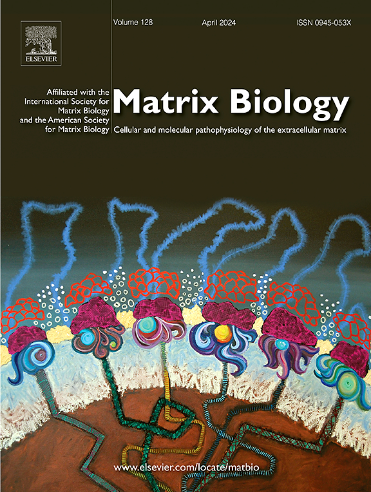斑马鱼col4a1的缺失再现了与单基因脑血管疾病相关的脑血管表型
IF 4.8
1区 生物学
Q1 BIOCHEMISTRY & MOLECULAR BIOLOGY
引用次数: 0
摘要
脑血管病(cSVD)是血管性痴呆和中风的主要原因。我们对cSVD病理生理的理解是不完整的,我们治疗患者的能力是有限的。IV型胶原α 1 (COL4A1)的致病性变异通过扰乱脑血管基底膜导致单基因型cSVD,其发病年龄不同。斑马鱼幼鱼由于其光学清晰度和活体成像的适用性,是研究脑血管疾病的有力模式生物。在这项研究中,我们对col4a1相关的功能丧失cSVD的斑马鱼脆化模型进行了表征,该模型成功地概括了关键的疾病特征,包括自发性脑出血和脑血管异常。我们还发现了与col4a1缺失相关的脑血管基底膜异常和基质金属蛋白酶9 (mmp9)转录升高的证据。药理抑制mmp9足以改善一些脑血管表型。最后,我们描述了斑马鱼col4a1 (col4a1Δ20)中携带可种系传播的20bp缺失的突变系的产生,该缺失与幼虫期脑血管异常、游泳缺陷和对药物诱导的脑出血的易感性增加有关。成年后,突变col4a1Δ20动物发生自发性脑出血,在自由游动的鱼类中也可以观察到。总的来说,本研究验证了斑马鱼疾病模型在临床前col4a1相关cSVD研究中的应用,并强调了其在进一步了解疾病病理生理和未来药物发现项目方面的潜力。本文章由计算机程序翻译,如有差异,请以英文原文为准。
Loss of col4a1 in zebrafish recapitulates the cerebrovascular phenotypes associated with monogenic cerebral small vessel disease
Cerebral small vessel disease (cSVD) is a major cause of vascular dementia and stroke. Our understanding of cSVD pathophysiology is incomplete and our ability to treat patients is limited. Pathogenic variants in type IV collagen alpha 1 (COL4A1) cause a monogenic form of cSVD with variable age of onset, via disturbance of cerebrovascular basement membranes. Zebrafish larvae are a powerful model organism for studying cerebrovascular disease due to their optical clarity and applicability for live imaging. In this study, we characterised a zebrafish crispant model for loss-of-function COL4A1-associated cSVD that successfully recapitulates key disease features, including spontaneous intracerebral haemorrhage and cerebrovascular abnormalities. We also identified evidence for abnormal cerebrovascular basement membranes and elevated matrix metalloproteinase 9 (mmp9) transcription associated with loss of col4a1. Pharmacological inhibition of mmp9 was sufficient to ameliorate some cerebrovascular phenotypes. Finally, we describe the generation of a mutant line carrying a germline-transmissible 20 bp deletion in zebrafish col4a1 (col4a1Δ20) which is associated with cerebrovascular abnormalities, swimming defects and increased susceptibility to pharmacologically induced brain haemorrhages during larval stages. In adulthood, mutant col4a1Δ20 animals developed spontaneous brain haemorrhages that were observable in free-swimming fish. Overall, this study validates the use of zebrafish disease modelling for preclinical COL4A1-associated cSVD research and highlights its potential for further understanding disease pathophysiology and future drug discovery projects.
求助全文
通过发布文献求助,成功后即可免费获取论文全文。
去求助
来源期刊

Matrix Biology
生物-生化与分子生物学
CiteScore
11.40
自引率
4.30%
发文量
77
审稿时长
45 days
期刊介绍:
Matrix Biology (established in 1980 as Collagen and Related Research) is a cutting-edge journal that is devoted to publishing the latest results in matrix biology research. We welcome articles that reside at the nexus of understanding the cellular and molecular pathophysiology of the extracellular matrix. Matrix Biology focusses on solving elusive questions, opening new avenues of thought and discovery, and challenging longstanding biological paradigms.
 求助内容:
求助内容: 应助结果提醒方式:
应助结果提醒方式:


